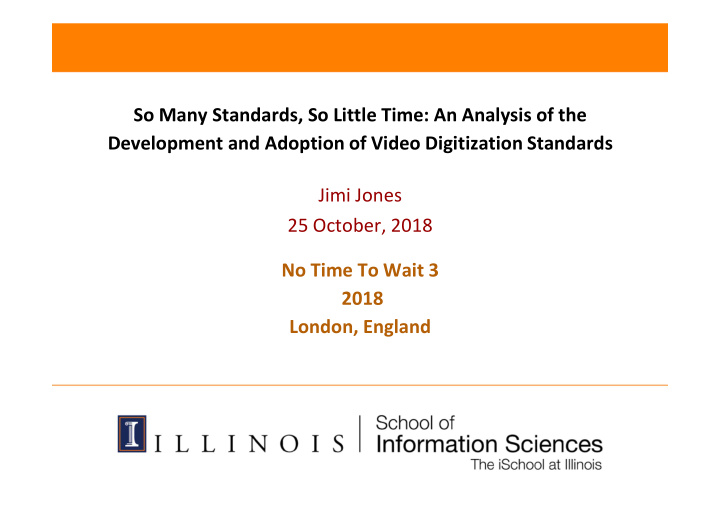



So Many Standards, So Little Time: An Analysis of the Development and Adoption of Video Digitization Standards Jimi Jones 25 October, 2018 No Time To Wait 3 2018 London, England
Introduction • Analog video recordings are deteriorating rapidly - content will be lost • Many standards to choose from for digitizing video at preservation quality • This thesis is a qualitative analysis of two examples of standards development and their implementation 2
Industry-Influenced Standards • Developed with considerable input from cinema and broadcast industries • ‘AS-07’ developed to support the digitization efforts at the Library, especially their AV facility in Culpeper, VA • MXF (Material Exchange Format) container and JPEG2000 lossless compression for picture essence 3
Open-Source Standards • Completely open specifications, not beholden to industry; developed with considerable input from the memory realm • CELLAR working group of the Internet Engineering Task Force (IETF) • Standardizing Matroska (MKV) multimedia container and FF Video Codec 1 (FFV1) lossless video compression codec 4
Theoretical Lenses Social Construction Of Technology • Draws from the work of scholars like Trevor Pinch, Jonathan Sterne and Steve Woolgar • Technologies as evolutionary - as a result of variation and selection and not as a smooth, orderly progression • It is not always the ‘best’ technologies that win out • Technologies themselves also have interpretive flexibility 5
Theoretical Lenses Political Economy • Draws heavily from the work of Vincent Mosco • Looks at market relationships beyond the traditional economic binary of ‘producers’ and ‘consumers.’ • Studies the power relations that define development, consumption and distribution of resources • Standards, like any product, can be influenced by power relations 6
Research Questions 1. How do power and influence dynamics affect two particular standards development groups as they work to create high quality video digitization standards and to define the concepts of quality and sustainability for the moving image preservation community? 1. What roles do open-source and industry-influenced moving image digitization encodings and formats play in the moving image preservation community’s efforts to solve problems related to their work? 7
Methods Interviews to learn about standards development • People who develop the standards – Kate Murray, LC – Dave Rice, CUNY, MKV/FFV1 • People who use the standards and worked on their development – James Snyder, engineer, LC – Mike Casey, Indiana University 8
Methods Site visits for interviews and observation • National Audiovisual Conservation Center in Culpeper, VA • Indiana University, Bloomington • Vienna for No Time To Wait 2 • Scene Savers in Cincinnati, OH 9
Methods Critical discourse analysis for studying standards documents and communications of standards groups • Standards documents • Drafts of standards documents • Email list communications • Forum posts • Professional blogs • Conference presentations • Meeting minutes and other internal documents 10
Discussion • Shift in adoption of technology from industry hand-me- downs to memory community influenced and/or open- source tools • Development of digitization tools is more participatory and less “wait and see” 11
Discussion • Cost of standards documentation is often a hindrance to adoption of said standards • This cost makes open technologies like FFV1 and Matroska more attractive 12
Discussion • Early adopters like the Austrian Mediathek got a lot of resistance to their avant-garde implementation of FFV1 • Synchronous and asynchronous communication tools make it much easier to collaborate and to disseminate information about new technologies • Lowered cost and increased availability of user-friendly digitization and editing software tools increases the attractiveness of technologies like FFV1 and MKV 13
Discussion • Matroska and FFV1 is being adopted by some European broadcasters • American broadcasters will, ultimately, need to deal with these standards as well, even if they do not implement them for preservation or broadcast 14
Discussion • Conscious shift in alignment for some preservation professionals. • Mike Casey, Indiana University, 2017: “We also believe that it is more fruitful, given our specific preservation requirements, to align ourselves with the FFmpeg community rather than with QuickTime developers and Apple.” 15
BUT! • This paper does not take an open-source vs. industry position. • And it is not a story of adversaries. This is, among other things, the story of a growing shift in attitude in the preservation realm re: open-source technologies. 16
Closing • The clock is ticking for legacy magnetic video materials • Institutions are feeling the pressure to digitize video • My work can help illuminate how standards are developed and implemented for video digitization 17
Thank you! Jimi Jones jjones7@illinois.edu https://ischool.illinois.edu/people/jimi-jones 18
Selected References Casey, Mike. Encoding and Wrapper Decisions and Implementation for Video Preservation Master Files. Available at: https://mdpi.iu.edu/doc/MDPIwhitepaper.pdf. Accessed on October 1, 2018. Federal Agencies Digitization Guidelines Initiative (FADGI). (2010). Audio-Visual Format Documentation Project: Background Paper. Available at: http://www.digitizationguidelines.gov/guidelines/FADGI-AV_AppSpecProj_Bkgd_101007.pdf. Accessed on October 1, 2018. MediaConch. http://www.preforma-project.eu/mediaconch.html. Accessed on October 1, 2018. Mosco, Vincent. (2009). The Political Economy of Communication: Rethinking and Renewal . Thousand Oaks, CA: Sage Publications. Pinch, Trevor J. and Wiebe E. Bijker. (1987). “The Social Construction of Facts and Artifacts: Or How the Sociology of Science and the Sociology of Technology Might Benefit Each Other”. In The Social Construction of Technological Systems . Cambridge, MA: MIT Press. 17-50. Sterne, Jonathan. (2012). MP3: The Meaning of a Format . Durham, North Carolina: Duke University Press. 19
Recommend
More recommend